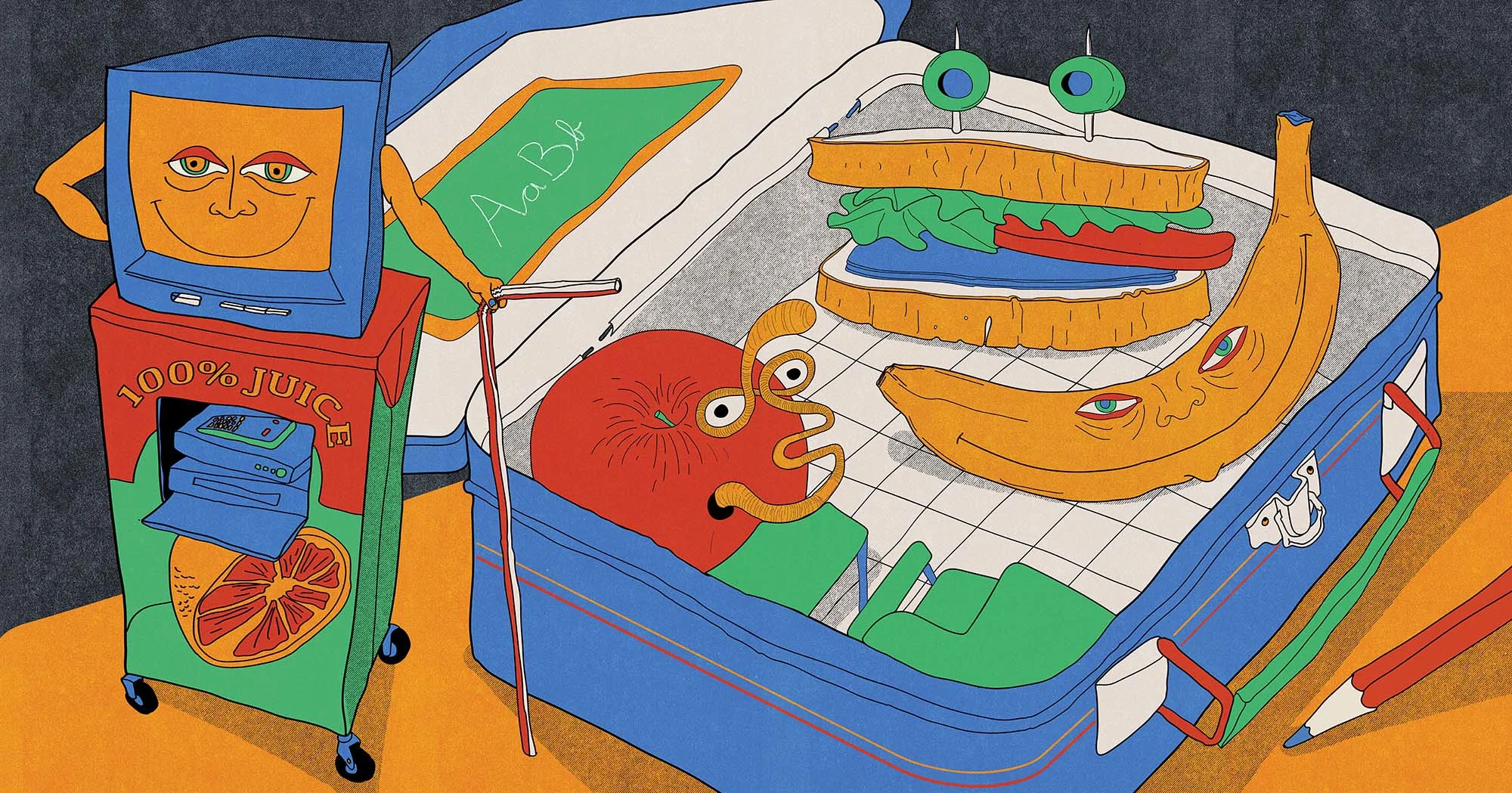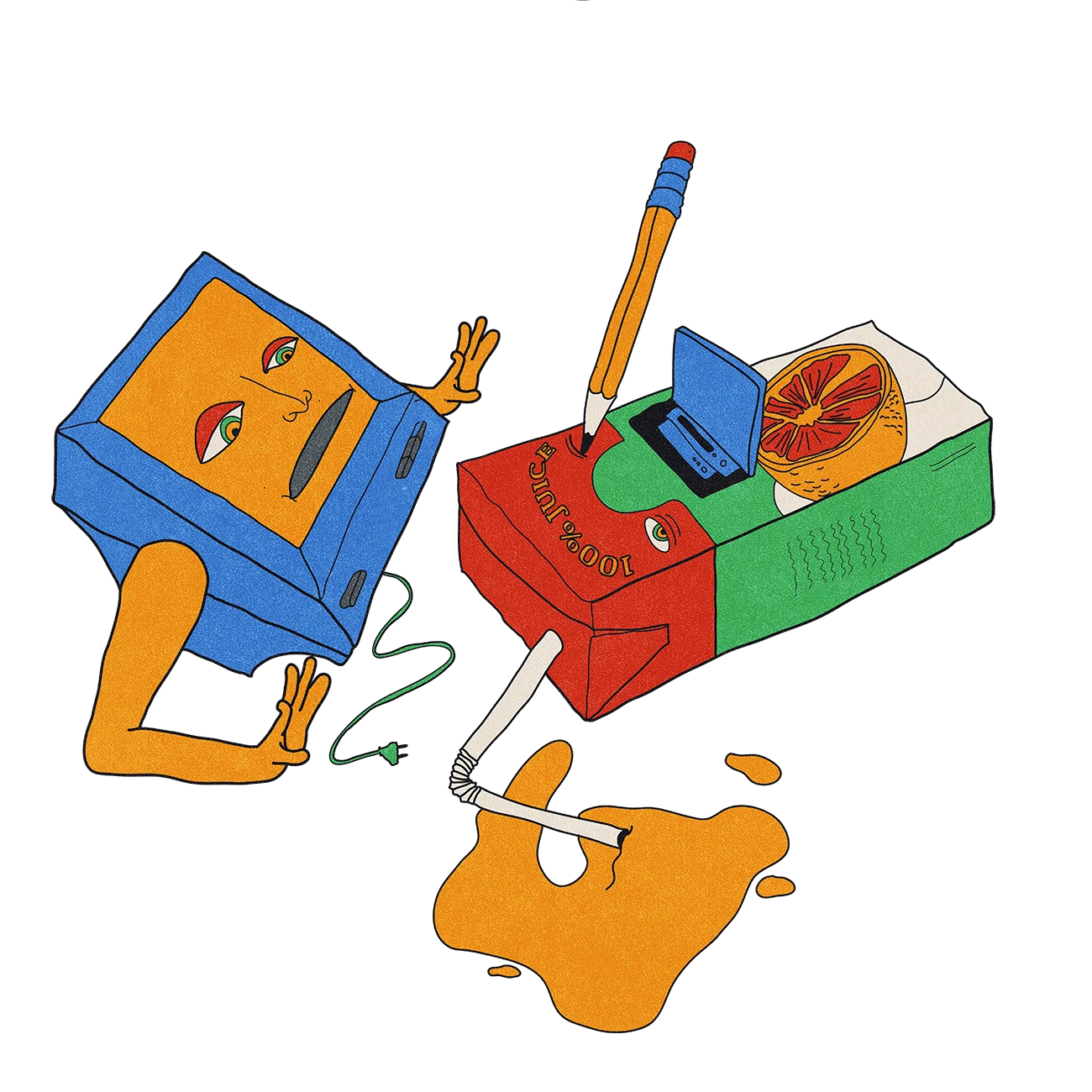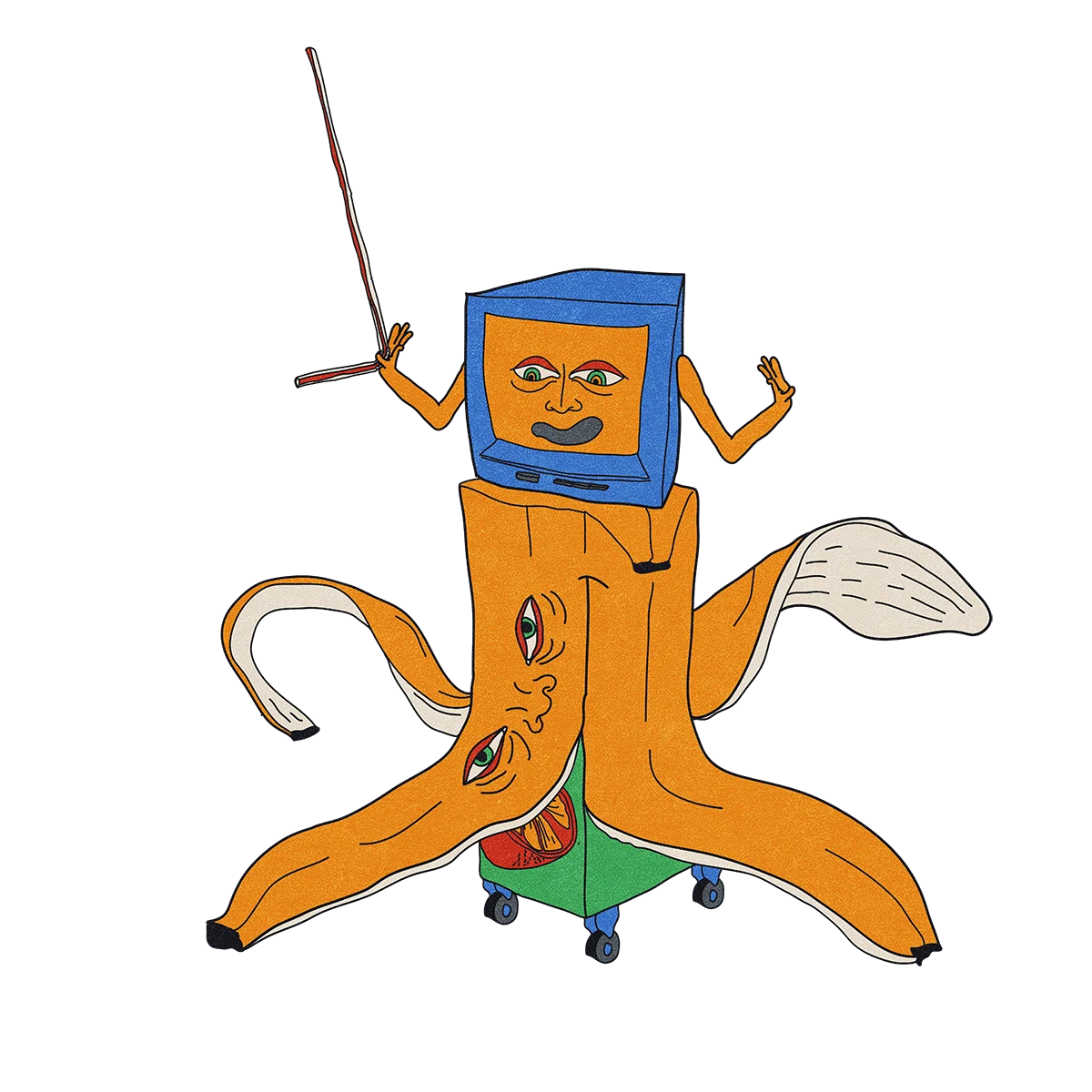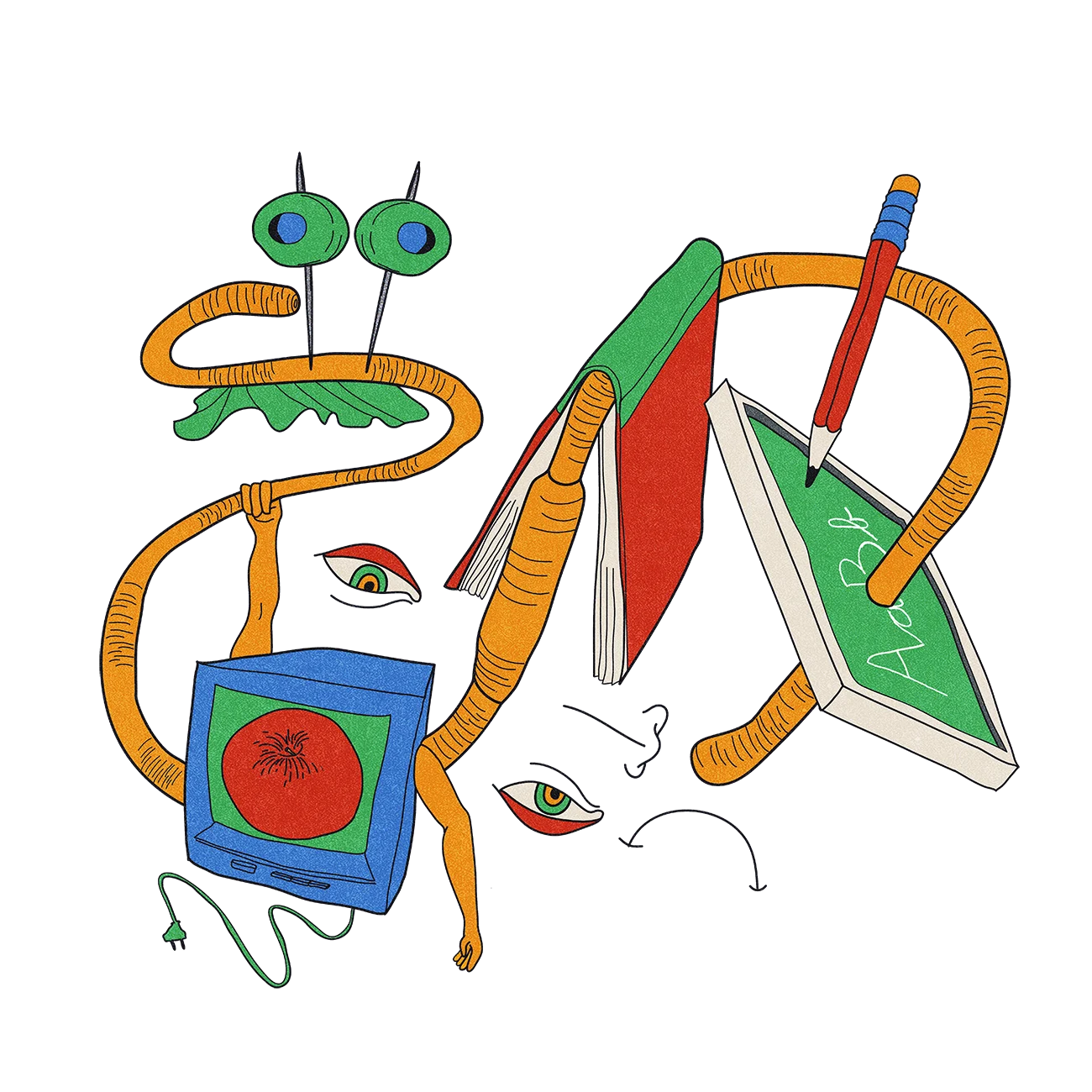

Rainy days, the end of term, or teachers calling in sick tended to mean one thing at school: time for the class to watch an educational film. What were those films? Who made them? Did we actually learn anything from them or were they just really scary? Joel Golby spent time trying to answer these questions. His findings are below. Remember to concentrate, you’ll be quizzed at the end about what you learned.
Illustrations by Maria Jesus Contreras.
All of the great theatrical performances are built on the solid foundations of tradition and ceremony, and this one is no different. The lights are dimmed, the blinds are drawn. Light lays low upon the room. In here, in the gloom and the mischief-glinted darkness, a crackle of something intangible – a shift in mood, the thrill of disobedience, a shushed tinkle of stifled laughter. At the door, a single spotlight of ambience from the hallway. And then our ringmaster enters: a mute science technician who everyone rumoured was head of department, once, until he had a breakdown and threw a chair at that Year 7. “Ah, yes, Mr. W———,” your teacher says, as he silently shuffles onto stage an old CRT TV locked into a special trolley and glued to a VHS player. A holy hush. She’s going to say it. She’s going to say it. She says it. Yes. “Well for today’s lesson,” the teacher says, “a little treat: we’re going to watch a video.” And for the next 45 minutes a man who cut his own hair and died in the ‘70s would explain photosynthesis to you at the pace of a glacier.
For a child, what could be better than sitting sleepily in a darkened room, chewing contraband snacks and not paying attention?
But then the lure of the educational video pulls you irresistibly in: a calm voice tells you of the mysteries of the ocean; a man with an ungroomed beard stands emotionlessly in front of some cream-colored industrial machinery; an incredibly lo-fi, three-cel animation tells you how frogs are born and die. All of this time you thought you weren’t learning, and then you come to with a start, fully adult now, and up from the Mariana trenches of your memory comes a factoid: “There are over 40 species of dolphin living in the ocean today,” you say, or, “Arachnids include scorpions, mites and ticks.”
Of all the crumbling bricks of knowledge that make up the cathedral that is your brain, there is no doubt that some of them were bafflingly relayed to you via a warped video watched in a greying science lab while rain pelted the window outside. But who made them? Why did they occupy such a strange aesthetic beige zone? Are they the same around the world? And do kids still have to watch them today? Speaking to experts, non-experts and former children alike, I aimed to find out. Open your workbook, and we shall begin.
Turn to page 1: The nature of fear

To understand the educational video, it is important to understand the concept of fear itself. My first experience with watching an E.V. was in primary school, when a local police officer came to our assembly, handed out embroidered caps for those brave enough to ask a question, gently closed the curtains then showed us all a 20-minute video where a succession of careless children got maimed to death on train tracks. Have I played on a train track since? No. Had I played on one before? Also no. I do not know how much of an issue children playing on train tracks was in the early ‘80s when the video I saw was produced, but you have to assume it pre-dates the invention of real fun (the invention of the Megadrive).
Ask people what their memories are of watching videos at school and you can draw an international map of horror, a geography of fear based on various unique-to-their-locale ways children could die if they stopped paying attention and the tapes that taught them to be afraid of them. In England we had the constant threat of trains blasting us apart and also fireworks, which, if held too long in autumn, would explode all of our arms and legs off in one go. This is also a threat in Lithuania: “The most vivid ones I remember were the ones telling us not to buy fireworks and play with them in wintertime,” Indre tells me. “They included gory scenes of hands with fingers missing and faces fucked up by small explosions”. In India, the menace of contaminated water loomed large. “I have very fond memories for a public information film that taught you how to make an oral rehydration solution, so that you or your small child or your elderly parent didn't crap themself to death with diarrhoea,” Lekha, who moved to the UK from India in her early twenties, tells me. “I still get a Pavlovian response on seeing garden ponds,” she continues, “because of all the public health films about how still water breeds mosquitoes and how you'll die horribly because you let a bit of water collect in a dish.”
To understand the educational video, it is important to understand the concept of fear itself.
In Argentina, reckless driving led to a boom in hi-octane safety videos in which drivers would proudly boast about going 120km/ph in a 90-zone before crumpling off the road and into a valley, while another, promoting seatbelt use, featured a woman saying the line, ‘Seatbelt? It wrinkles my clothes!’ “They've become iconic and some of the phrases are ‘memes,’ especially for people of my generation,” Cammi, an Argentinian ‘90s kid, tells me. “They were so intense they make me laugh to this day, but I’m also obsessive about people wearing their seatbelt, so I guess they worked.”In Finland, Anna tells me, children are taught to fear the very surface beneath their feet, in case a misplaced Särmä sees them plunge through delicate ice into the freezing water below. “I remember being traumatised by it,” she says. “I never went on thin ice, though, so I guess it worked.” Watch the wordless warnings of Varokaa Heikkoa Jäätä – or, “Beware of Thin Ice” – and see how the educational video so easily zigs into the world of eerie horror: a barely motional teddy bear, a square bird that honks like a siren, an ambient soundtrack as if taken from a fever dream. Varokaa Heikkoa Jäätä teaches us two things: you can crawl on ice and use your scarf as a primitive lasso; and the world is edged with a baseless terror that makes you soul unanchor from your body and float around there, gurgling, in the pit of your stomach. The ice breaks. The water freezes. A bird like a fridge screams that you are going to die.
Turn to page 2: On replacing the teacher

Safety videos warning children not to get maimed are different from educational videos of goggled-up scientists explaining the elements, but they are both built on the same rough principle: that just-about-produced visuals can reach the parts traditional lecturing-in-front-of-a-blackboard can’t. That was the hope with Discovery, Granada TV’s first school programme, which launched in 1959 with the boast, “The aim of the series is to give Sixth Form students the opportunity of seeing, in their own classrooms, leading scientists talking about their work. Each lecture will last for half-an-hour." Though not the first schools programme broadcast on British TV (that was the hastily conceived and short-running Looking And Seeing, in 1957 – educational radio shows had been humming in the background since the ‘30s), it was the first to attempt to more seriously align with the syllabus, with Granada appointing their own educational advisor, Sir Gerald Barry, and establishing a research post at the local University College of North Staffordshire (dubbed “the Granada Chair”) taken up by future schools programme host Dr Donald McKay.
Many of the shows played in what was then the pre-This Morning dead zone of broadcasting during the working and school day – The Broadcasting Act of 1972 meant broadcasting hours were regulated by the British government, but exemptions for sports and educational programming meant a boom in production of low-budget public service programming that was repeated, again and again, often for decades. Granada’s idea was that schools programming would be very serious – lecturers in the 161-episode series including moon shagging monocle-enthusiast Sir Patrick Moore, as well as Professor Heinz Wolff – with the onus on illustrated lectures showing what traditional teaching couldn’t. In one 1961 feature, surgeons from the University of Manchester gave a stuffed toy (Peter the Panda) treatment on a heart-lung machine, using modelling clay for the organs and plastic tubing for the arteries. No matter how engaging your teacher might be, they’re not putting a stuffed panda on life support for banter.
In England we had the constant threat of fireworks, which, if held too long, would explode all of our arms and legs off in one go.
Discovery was replaced in 1969 by Experiment , which became the ur-text of school programming as it lives in the minds of ‘80s, ‘90s and ‘00s kids (do you have vague, fuzzy memories of watching two distant figures walk around an iron ore refinery in shoe-tapping silence? Then you have seen Experiment or one of its spin-offs), which was written, devised and often narrated by former chemistry teacher Jack Smith. Jack taught at the prestigious King’s College School in Wimbledon (it was there he developed the Film Unit, which produced a 15-to-20 minute original each year and premiered it in the school’s Great Hall) before moving to Granada, where he headed up the channel’s schools programming for a number of years. Experiment was supposed to emulate interesting practical experiments which couldn’t be easily recreated in a classroom, and schools were provided with work booklets so students could take down readings from the screen.
But as well as recreating explosions from a safe distance, the advent of educational videos allowed teachers to outsource the more awkward aspects of educating teenagers, namely sex ed. Sex education videos run the broad gamut – from awkwardly dry diagrammatical testes-and-vagina stuff , through this Irish Catholic sex education video that starts with a reverent prayer and ends with some inelegant fingerbanging, through to this ‘60s-era American PSA movie aimed at parents, where two men with the vibe of high-level FBI interrogators tell boys in letterman jackets that it’s OK to masturbate if they absolutely have to do it (this was actually filmed in an era of high frankness in American sex education: previous efforts from the ‘50s just involve a gym full of boys asking a wily teacher “say, when’s a fella start shaving?”)
When difficult subjects come up, what’s easier: blush yourself pink in front of a roomful of teenagers who just discovered what body hair was, or outsource the shame to a straight-up no-messing educational video? “Documentaries for PSHE are invaluable,” Kirsty, an English teacher from south Yorkshire, tells me. “Sometimes I can't do difficult topics justice. I think videos are a great tool we don't utilise enough – YouTube alone has thousands of videos I watch to give myself ideas before I teach them on. So sometimes it just makes more sense to show a video… although I do love teaching sex ed.” This is why everyone learned what testicles were from a strange warped video cassette while a PE teacher stood at the back of the class trying not to make eye contact with anyone. It was just easier to teach it that way.
Now turn to section 3: Fever dream aesthetic

”I was in the comedy department at Granada TV and I realised they had an amazing library,” Robert Popper tells me over the phone, “we were talking about those weird programs you used to watch at school – they were sort of like a dream in your head when you remember them – and I used to do request for shows. They’d all have this weird blue background, and they were really spooky...you’d only watch them about three times a year, or if you were off ill, and they'd be on TV either really early in the morning or late at night in a slightly terrifying, bleak way, with a weird voice over and just no atmosphere.” After racing through seven-episodes-to-a-tape bumper editions of Jack Smith’s entire back catalogue – “Experiment was the main one, but there was also Physics in Action and Chemistry in Action” – Popper and co-writer Peter Serafinowicz set out to create a short film lampooning his pervasive and ever-so-slightly-strange scientific style. “We said, ‘Well why don’t we write our own education film, for fun? About, I don’t know, calcium.’ I don’t even know why, we just found it funny that we were writing a comedy about calcium.” And with that, semi-nightmarish cult BBC comedy Look Around You was born.
The first series of Look Around You – a straight send-up of Smith’s educational style, 10-minute shorts that involve a blend of faux archive footage, blue backdrops and pointing at things with a sharpened pencil, accompanied by a mellow narrative track – was made in much the same way most of Smith’s films were, which is: cheaply and quickly. “With the originals, they obviously had no money,” Robert says, “They would have shot it on film, which we shot on, but film is expensive, so they wouldn't have done loads of takes – a lot of the time a scientists’ head was chopped off at the top, or something. And crucially: every shot is about information. It's not entertainment, ever. So that’s what we did with Look Around You: everything is shot purely for information, but all the information we get is insane.” Sound design was an important part of getting the texture right, too: “You just hear the workings of a lab in the background, and test tubes clinking now and then, and shuffling,” Robert says. Educational films rarely focus on being actually entertaining, because a narrative track is always on hand to stir sleepy students into paying attention with the threat of a quiz at the end. Everything is there just to show, in the most straightforward way possible, how sulfur reacts with oxygen.
The ice breaks. The water freezes. A bird like a fridge screams that you are going to die.
By the ‘80s, educational programming had started to take more cues from children’s television – among north Americans, one of the most fondly recalled shows was PBS’ The Voyage of The Mimi , a half-fictionalised half-documentary series featuring a young Ben Affleck, alternately acting as a kid inexplicably working on a humpback whale census expedition, before travelling as a roving documentary host interviewing various scientists in front of machinery. In 1983, the Long Island Poison Control Council released a PSA of four singing tablets that later inspired the 1997 Busta Rhymes song, Dangerous (“this is serious / you should have a healthy fear of us”). Produced in the ‘70s but repeated apparently every single day up until now, episodes of Schoolhouse Rock – included the Simpsons-inspiring I’m Just A Bill – burn bright in the American psyche. If you ever meet a Canadian at a party, ask them about French-language programme Téléfrançais! , an ‘80s-era TV show where a frankly insane-looking pineapple puppet attempts to teach elementary school children conversational French (“I watched these in school from 2004–2007, and I think they are still used today,” Canadian Liv tells me. “There’s a very distinctive theme song that I can still sing word for word. It’s the only French I have retained from school”).
France’s favorite educational programme C’est Pas Sorcier (It’s Not Rocket Science), looks baffling to an outsider: after a squealing face-melting theme tune, hosts Fred and Sabine tour the country learning primary school-level science, then throw back to co-host Jamy Gourmaud – locked in the back of a huge chrome truck – who explains the complexities of the subject with intricate 3D models (over lockdown, Jamy went viral taking to Instagram Live and pulling all his old models down out of the loft. “A generation of us grew up being shown relevant episodes of C'est Pas Sorcier in school,” French-educated Alex tells me. “It had the most amazing energy and a rad guitar solo intro”). Now TV channels are less beholden to archaic laws that mean they have to put out weird advertless science programming in the middle of the day, the cherished tradition of watching a pair of disembodied hands mess around with some beakers while feeling like you’re hallucinating is dying out. Generation Z will never know.
Please rewind the tape and turn to the front

“So kids these days don’t know about the science technician?” I ask Kirsty the teacher. “The big CRT screen? The welded cabinet? The VHS?” It’s more subtle than that now, she explains, and more regulated. While I always assumed video lessons were just because the teacher was hungover and wanted to sit in a dark quiet room for a while (“No,” Kirsty says, firmly), teachers wanting to show videos and documentaries in their classes now have to be able to fully articulate how that assists with the syllabus – they can’t just boot up YouTube and hope it teaches the kids for them. “Every video has to have a reason for being shown that we can justify to the powers that be in school,” she explains. “I think videos are a great tool we don't utilize enough. I use Mr Bruff a lot because he's great at summarizing things it would take me ages to explain. Or sometimes I use him as an ‘in’ to a more difficult text.”
The blinds aren’t drawn, nobody is trying to attack me with a ruler, and I’m not worried about my SATs anymore.
So I boot up Mr Bruff on YouTube and scroll down until he’s talking about a book I can vaguely remember (it takes an embarrassingly long time until I stumble upon a little-known volume called The Great Gatsby). The blinds aren’t drawn, nobody is trying to attack me with a ruler, my body isn’t being flushed with a cocktail of hormones and I’m not worried about my SATs anymore, but some of the old beats are still there: Bruff’s videos are slick and engaging, but are still fundamentally a smartly patient narrative track over a series of illustrative images, just like Jack Smith was doing at the apex of the ‘60s; he presents knowledge in a way that makes me feel like I already know it already, I just don’t know it in the shape of a succinct answer to an exam question, so my mind is convinced I am both smart and dumb at the same time.
Maybe there is just some fundamental truth lying at the base of education: there is simply no way of truly tying it to entertainment, so you just have to fill it with information in a way that, if not compelling, makes it feel like revision cramming mixed with a fever dream. Sometimes it involves major surgery on a stuffed panda. Sometimes it involves Ben Affleck acting on a boat. Occasionally, occasionally, it involves a French-Canadian pineapple, fluently bizarre, wiggling along the line of horror and comprehension until it is close, so close, a pale blue background glowing eerie behind you, and the pineapple flutters its sleepy pineapple eyelashes and whispers, “tu as appris…”

